Abstract
In this study, local and systemic tolerance and pharmacokinetics of trospectomycin sulfate in human beings were evaluated for the first time. Trospectomycin sulfate (U-63,366F; trospectomycin) or sterile saline was administered to 96 healthy male volunteers in doses ranging from 0.25 ml (75 mg) to 3.3 ml (1,000 mg) in a single intramuscular injection in a double-blind, randomized design. Volunteers were screened to establish baseline vital signs and laboratory test values. Pain and tenderness at the injection site, which occurred at doses of 450 mg and above, were the most common side effects; they were mild in severity and transient. Adverse drug experiences reported by subjects included nausea, dizziness, light-headedness, diaphoresis, costal pain, and perioral numbness. The perioral numbness (paresthesia) experienced at doses of 750, 900, and 1,000 mg was probably drug related. No Clostridium difficile toxin was detected in fecal samples. Pharmacokinetic calculations based on data obtained by high-performance liquid chromatography showed that after a 1,000-mg intramuscular dose of trospectomycin (3.3 ml), the serum mean half-life was 1.85 h (1.70 to 2.02 h), mean area under the serum concentration-time curve was 140.2 micrograms.h/ml and was linear with dose, mean peak concentration was 28.3 micrograms/ml (20.4 to 34.7 micrograms/ml), mean time to maximum concentration was 71 min (30 to 120 min), and the elimination rate constant was 0.307 h-1. The elimination rate constant and half-life did not vary with dose. Little trospectomycin was detected in 2-day fecal collections. A few randomly occurring abnormal clinical laboratory test values and vital signs were observed. For the trospectomycin-treated group, creatinine phosphokinase increased substantially for 24 h after injection and then decrease through day 5, while serum glutamic oxalacetic transaminase and lactate dehydrogenase increased slightly.
Full text
PDF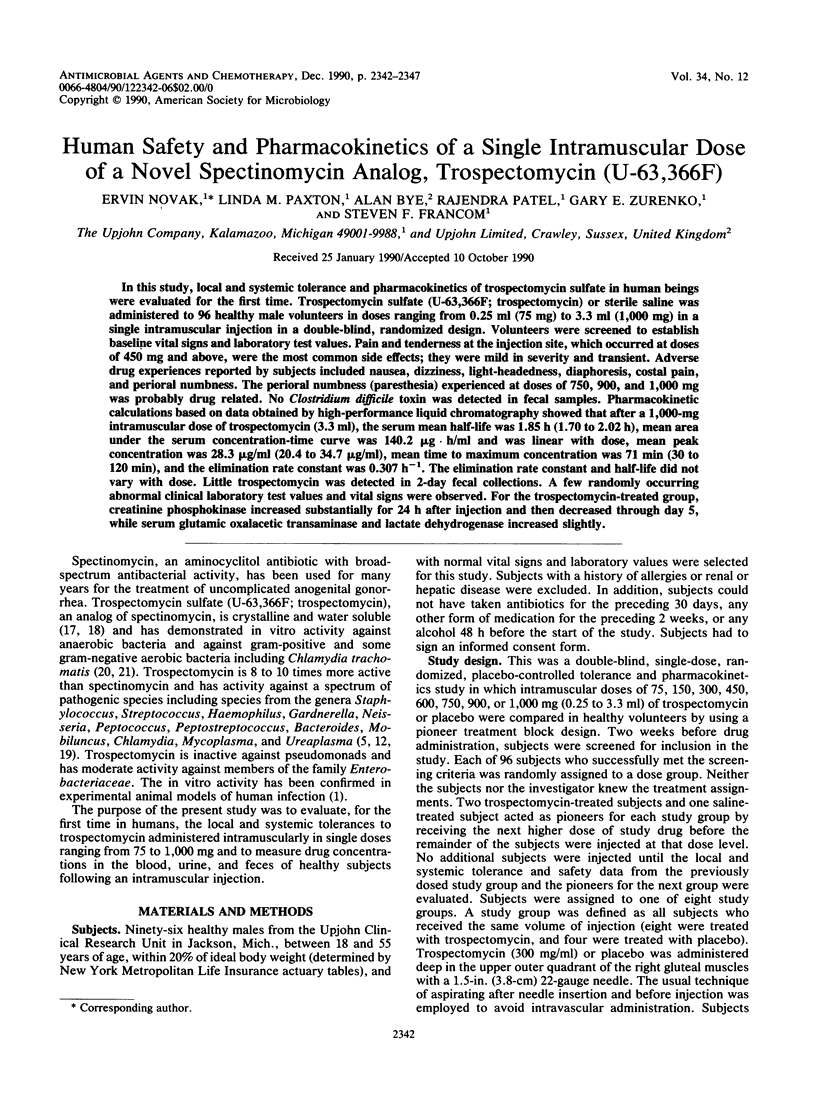
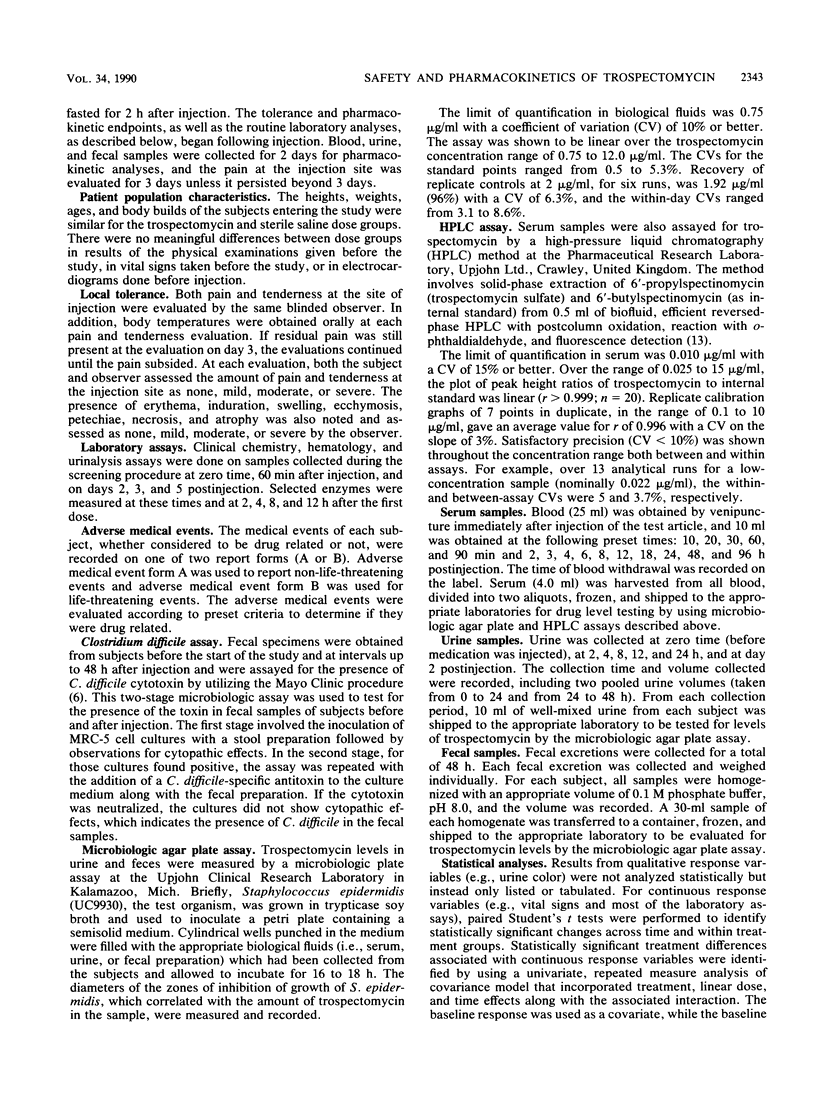
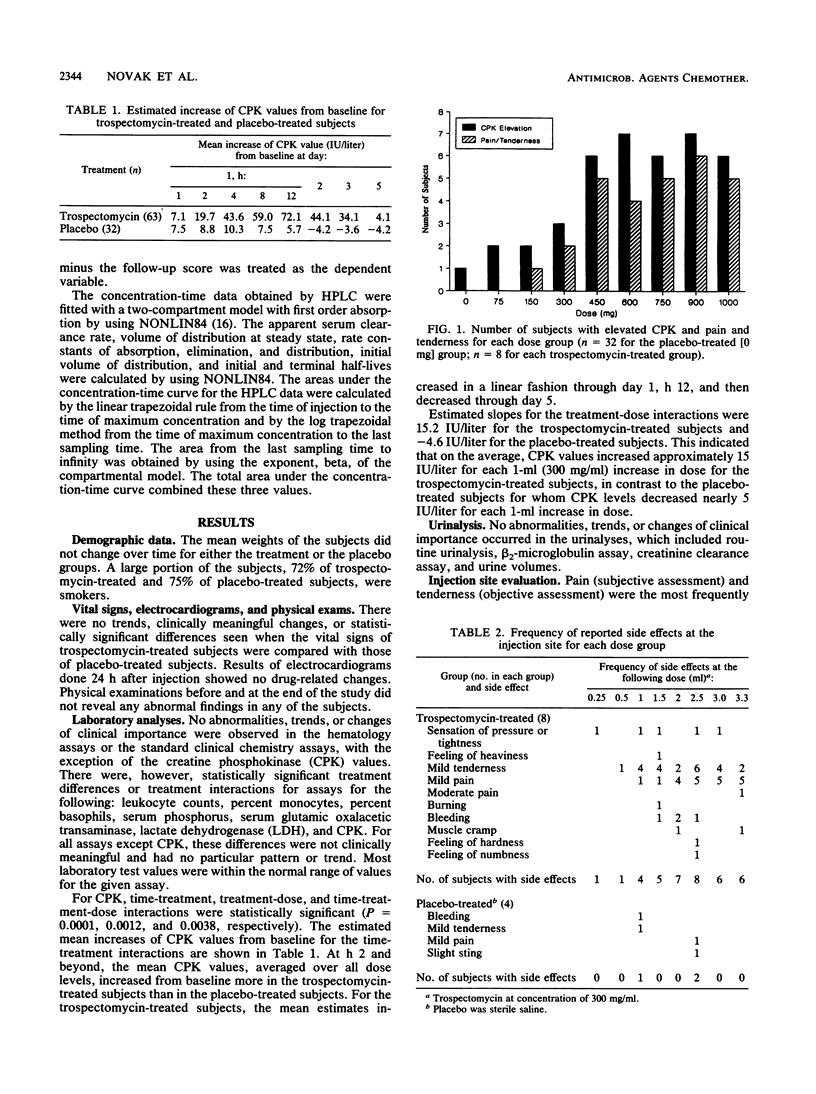
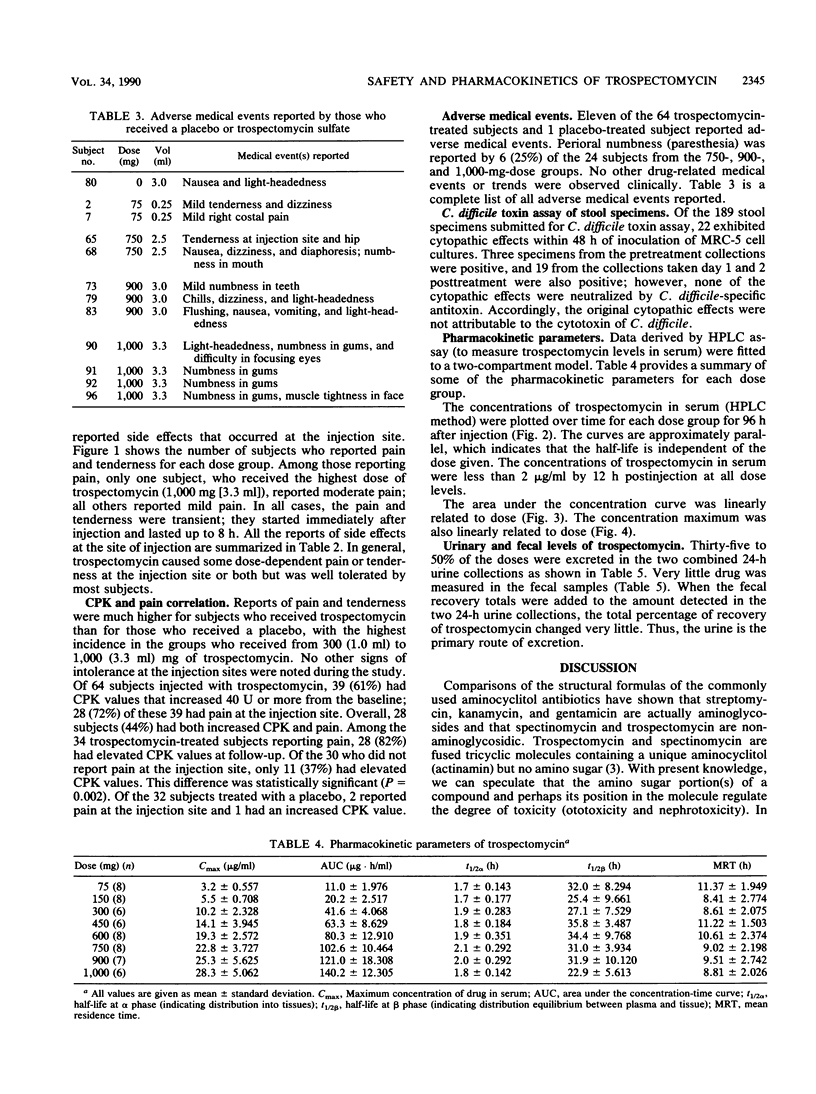
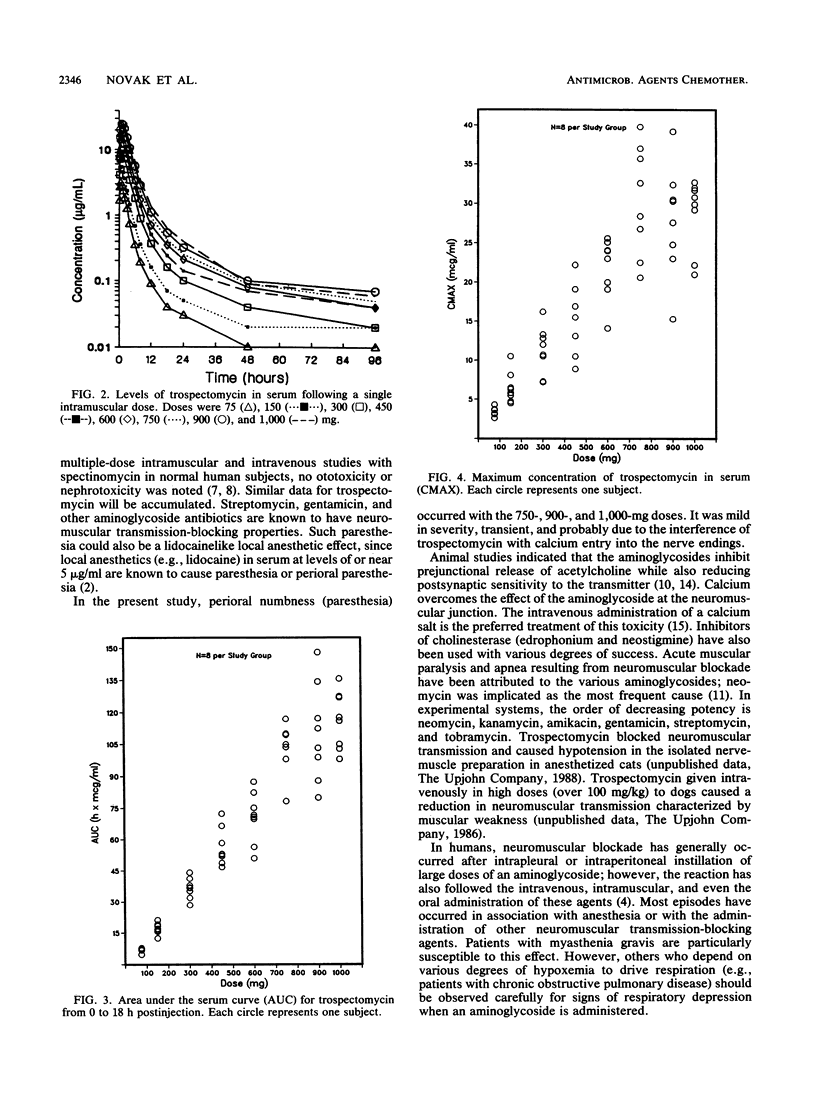
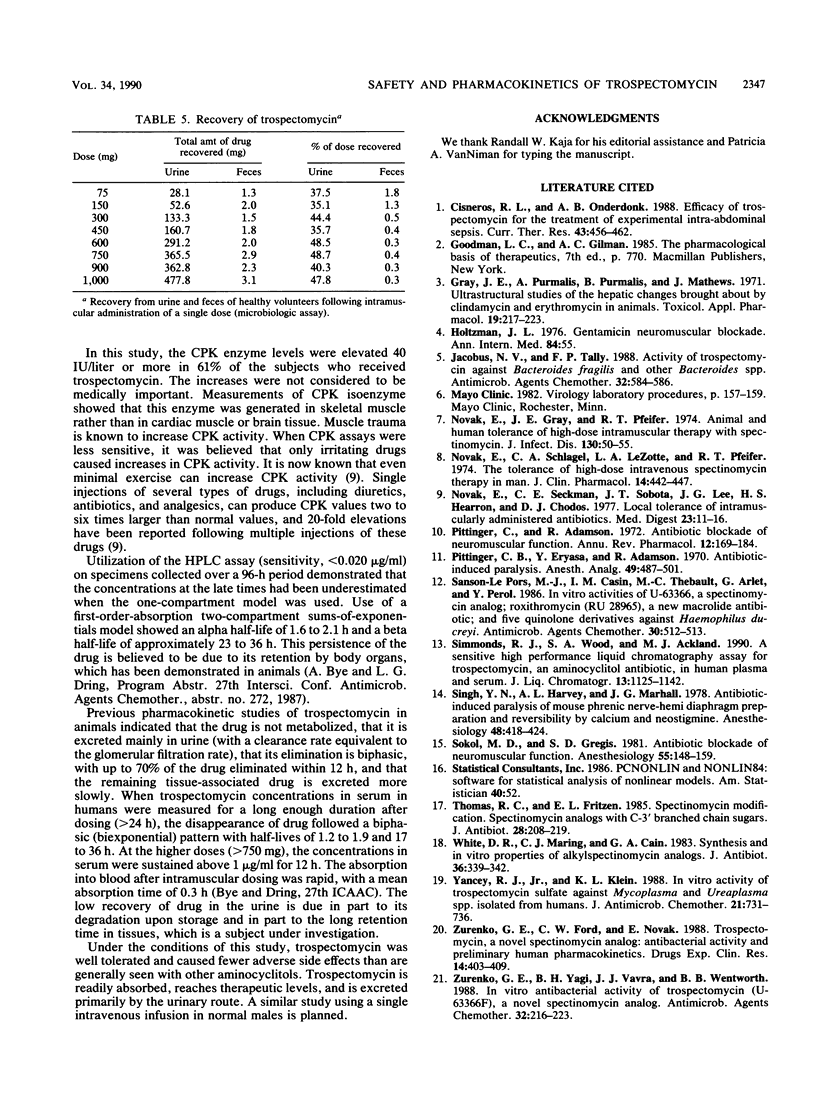
Selected References
These references are in PubMed. This may not be the complete list of references from this article.
- Gray J. E., Purmalis A., Purmalis B., Mathews J. Ultrastructural studies of the hepatic changes brought about by Clindamycin and Erythromycin in animals. Toxicol Appl Pharmacol. 1971 Jun;19(2):217–233. doi: 10.1016/0041-008x(71)90108-6. [DOI] [PubMed] [Google Scholar]
- Holtzman J. L. Letter: Gentamicin and neuromuscular blockade. Ann Intern Med. 1976 Jan;84(1):55–55. doi: 10.7326/0003-4819-84-1-55_1. [DOI] [PubMed] [Google Scholar]
- Jacobus N. V., Tally F. P. Activity of trospectomycin against Bacteroides fragilis and other Bacteroides species. Antimicrob Agents Chemother. 1988 Apr;32(4):584–586. doi: 10.1128/aac.32.4.584. [DOI] [PMC free article] [PubMed] [Google Scholar]
- Novak E., Gray J. E., Pfeifer R. T. Animal and human tolerance of high-dose intramuscular therapy with spectinomycin. J Infect Dis. 1974 Jul;130(1):50–55. doi: 10.1093/infdis/130.1.50. [DOI] [PubMed] [Google Scholar]
- Novak E., Schlagel C. A., LeZotte L. A., Pfeifer R. T. The tolerance of high dose intravenous spectinomycin therapy in man. J Clin Pharmacol. 1974 Aug-Sep;14(8):442–447. doi: 10.1002/j.1552-4604.1974.tb02326.x. [DOI] [PubMed] [Google Scholar]
- Pittinger C. B., Eryasa Y., Adamson R. Antibiotic-induced paralysis. Anesth Analg. 1970 May-Jun;49(3):487–501. [PubMed] [Google Scholar]
- Pittinger C., Adamson R. Antibiotic blockade of neuromuscular function. Annu Rev Pharmacol. 1972;12:169–184. doi: 10.1146/annurev.pa.12.040172.001125. [DOI] [PubMed] [Google Scholar]
- Sanson-Le Pors M. J., Casin I. M., Thebault M. C., Arlet G., Perol Y. In vitro activities of U-63366, a spectinomycin analog; roxithromycin (RU 28965), a new macrolide antibiotic; and five quinolone derivatives against Haemophilus ducreyi. Antimicrob Agents Chemother. 1986 Sep;30(3):512–513. doi: 10.1128/aac.30.3.512. [DOI] [PMC free article] [PubMed] [Google Scholar]
- Singh Y. N., Harvey A. L., Marshall I. G. Antibiotic-induced paralysis of the mouse phrenic nerve-hemidiaphragm preparation, and reversibility by calcium and by neostigmine. Anesthesiology. 1978 Jun;48(6):418–424. doi: 10.1097/00000542-197806000-00008. [DOI] [PubMed] [Google Scholar]
- Sokoll M. D., Gergis S. D. Antibiotics and neuromuscular function. Anesthesiology. 1981 Aug;55(2):148–159. doi: 10.1097/00000542-198108000-00011. [DOI] [PubMed] [Google Scholar]
- Thomas R. C., Fritzen E. L. Spectinomycin modification. III. Spectinomycin analogs with C-3'-branched chain sugars. J Antibiot (Tokyo) 1985 Feb;38(2):208–219. doi: 10.7164/antibiotics.38.208. [DOI] [PubMed] [Google Scholar]
- White D. R., Maring C. J., Cain G. A. Synthesis and in vitro antibacterial properties of alkylspectinomycin analogs. J Antibiot (Tokyo) 1983 Mar;36(3):339–342. doi: 10.7164/antibiotics.36.339. [DOI] [PubMed] [Google Scholar]
- Yancey R. J., Jr, Klein L. K. In-vitro activity of trospectomycin sulphate against Mycoplasma and Ureaplasma species isolated from humans. J Antimicrob Chemother. 1988 Jun;21(6):731–736. doi: 10.1093/jac/21.6.731. [DOI] [PubMed] [Google Scholar]
- Zurenko G. E., Ford C. W., Novak E. Trospectomycin, a novel spectinomycin analogue: antibacterial activity and preliminary human pharmacokinetics. Drugs Exp Clin Res. 1988;14(6):403–409. [PubMed] [Google Scholar]
- Zurenko G. E., Yagi B. H., Vavra J. J., Wentworth B. B. In vitro antibacterial activity of trospectomycin (U-63366F), a novel spectinomycin analog. Antimicrob Agents Chemother. 1988 Feb;32(2):216–223. doi: 10.1128/aac.32.2.216. [DOI] [PMC free article] [PubMed] [Google Scholar]


